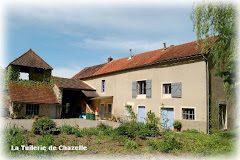The Beaujolais is outside France well known for its wines, in particular for its Beaujolais Nouveau which is promoted abroad each year with vigour.
 |
| Double identity |
Beaujolais is also well known in France, however, I think that many Frenchmen will associate the Beaujolais area first with the book Clochemerle, and only in second instance with the wine region. Clochemerle is the title of a book by Gabriel Chevallier set in the fictive village of the same name in the Beaujolais. But is it really fictive?
Rumour has it that Chevallier had modelled Clochemerle after the real village Vaux-en-Beaujolais. He not only used the lay-out of the village, but he also used the characters of some of the villagers. Another rumour had it that in some cases he did not even bother to change the names of the villagers!
 |
| Urinal with trompe l'oeil in the background |
Since I have read the book (with pleasure) at least 3 times, in English, Dutch and French, it seemed like a good idea to combine a visit to some Romanesque churches in the area with a pilgrimage to Vaux-en-Beaujolais. On entering the village it becomes very clear that the rumours are not really rumours. This impression was reinforced when we saw the village square. In the middle of it a public urinal had been erected as an homage to Chevallier, similar to the one that played a main role in the book and the building of which split the village into two camps. Overlooking the square stands a building on which a trompe l'oeil has been painted showing scenes from the book.
 |
| The fine bell tower of Vaux-en-Beaaujolais |
In a word, Vaux-en-Beaujolais ís Clochemerle, and obviously the village does not mind to use the similarity between the two villages to attract some tourists.
Although this blog is more about reality and fiction than about Romanesque architecture (which should be the subject of the blogs), even in
Vaux-en-Beaujolais one can find traces of the Romanesque period. The local church has a fine bell tower, an interesting portal that gives the impression to have been re-employed when the facade was renewed and two (not very common in this area) passages berrichons.
 |
| A re-employed portal? |
During our round trip we also visited
Saint-Etienne-la-Varenne,
Saint-Georges-de-Reneins,
Salles-Arbuissonnas-en-Beaujolais and
Belleville.
Certainly the last village boasts a beautiful church, not in the least because of the stunning sculpted columns.
The semicircular engaged columns adorning the nave appeared to have, halfway between the column base and the capital, strange reliefs, showing human or animal figures. The apse also has some beautifully carved pilasters.
 |
| View on choir, apse and passages berrichons |
For a detailed map showing some of the churches in the Beaujolais,
click here.
Even though we did not drink one sip of local wine during our trip, this particular visit appeared to leave an excellent impression of the area.
The Beaujolais lies at less than an hour's drive from
La Tuilerie de Chazelle.










